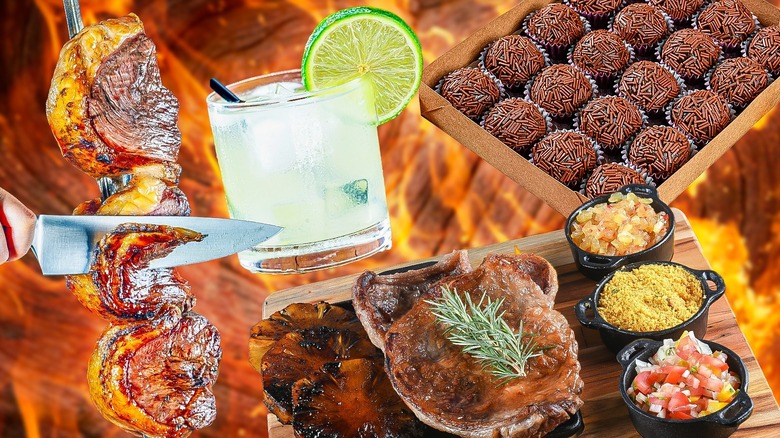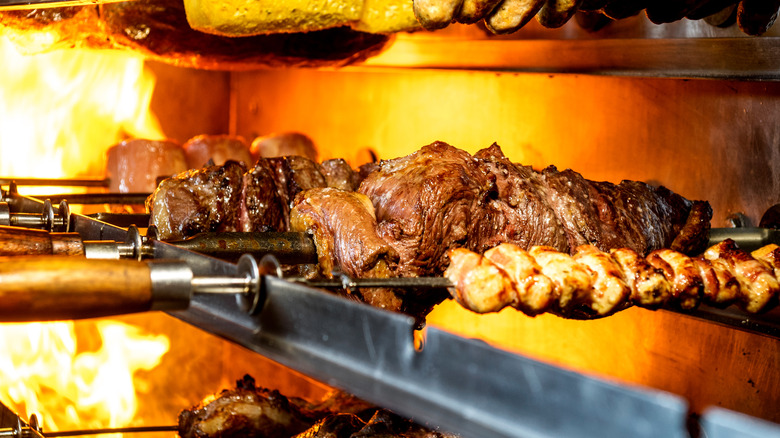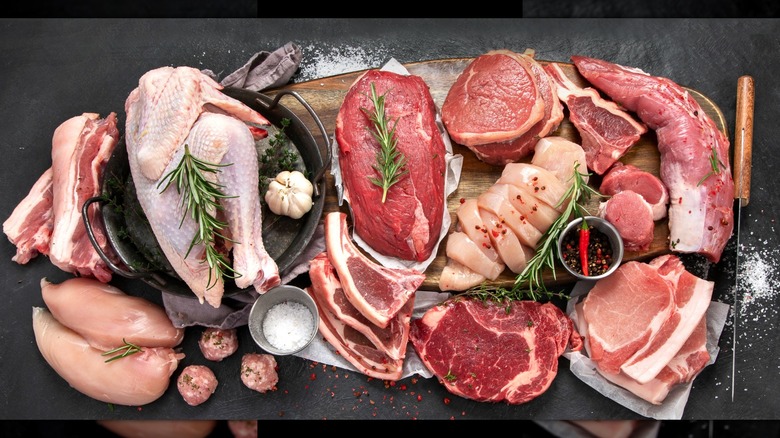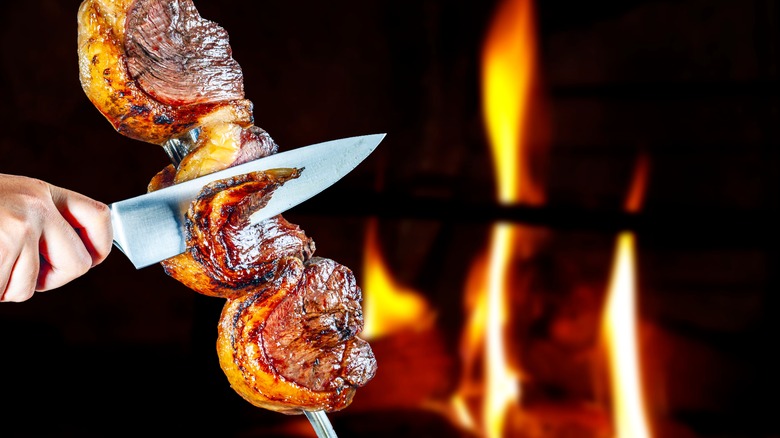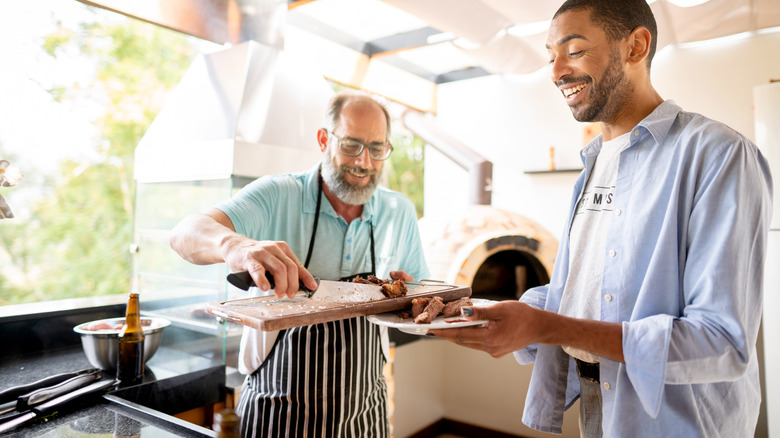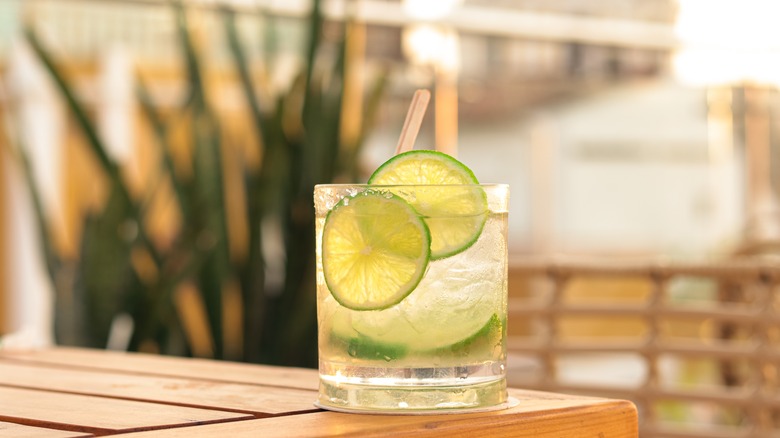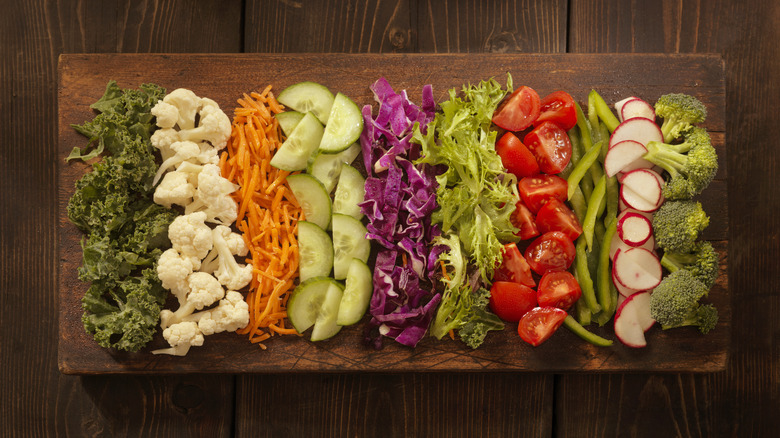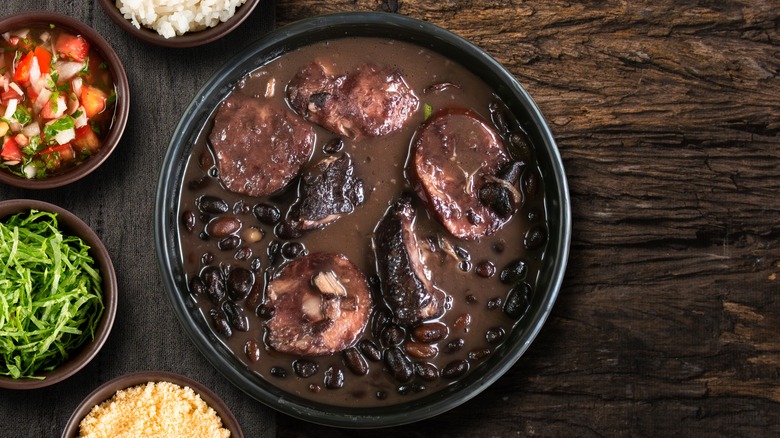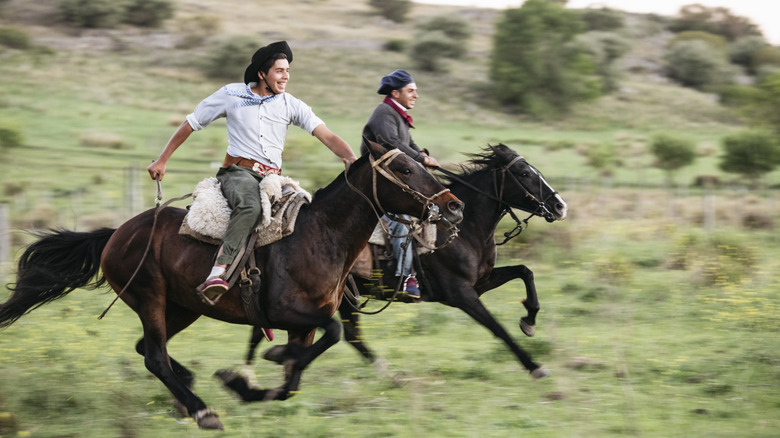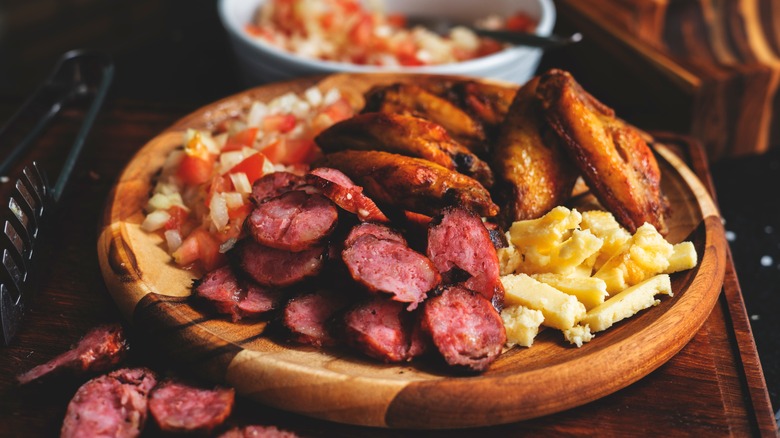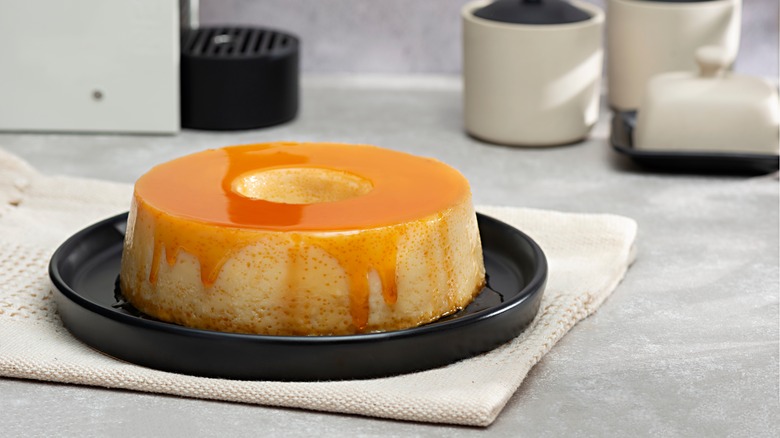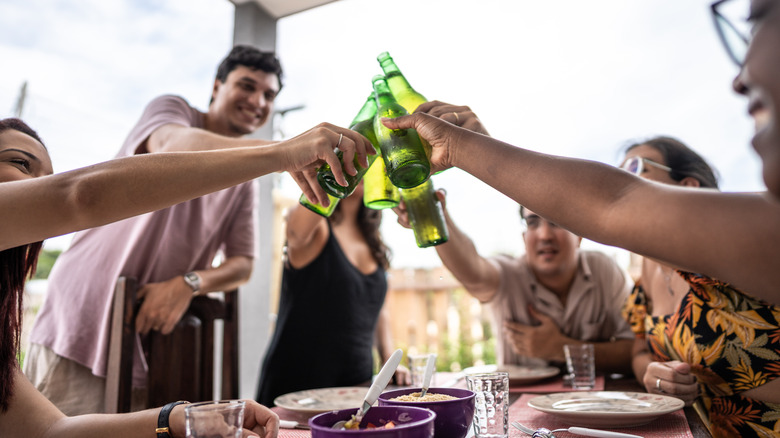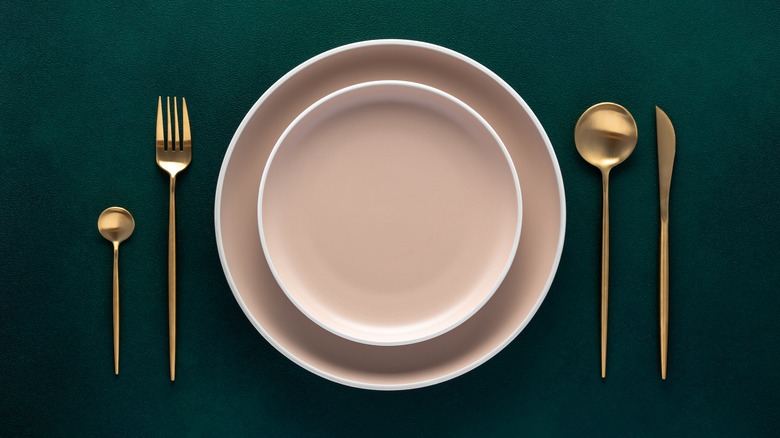12 Things You Should Know Before Eating At A Brazilian Steakhouse For The First Time
If you take a drive through the countryside in southern Brazil, you won't have to wonder why the Brazilian steakhouse originated there. Cows abound in the region's abundant grasslands, and a culture shaped by rustic, rural traditions still reigns supreme. Brazilian steakhouses serve churrasco, which is often translated as "Brazilian barbecue" but refers specifically to meat cooked on a skewer over an open flame.
Brazilian barbecue first made its debut in the United States in the 1990s and has since become a popular option for diners looking to get their fill of quality Brazilian-style meats and sides. To get the inside scoop on what to know before eating at a Brazilian steakhouse, we spoke with Neri Giachini, Director of Operations at Fogo de Chão, one of the most successful chains of Brazilian steakhouses in the U.S. Although Fogo de Chão isn't a traditional Brazilian steakhouse, its food offerings and service model are representative of what you're likely to find at one of these fun, relaxed, meat-forward restaurants.
As a former resident of Rio Grande do Sul, I've been to my fair share of Brazilian steakhouses, and I can tell you that dining at one is a culinary adventure you should experience. Although it's certainly a meaty affair, Brazilian steakhouses typically offer a huge variety of regional Brazilian dishes you need to try at least once. So, if you're thinking about eating at a Brazilian steakhouse for the first time, here's what to expect.
1. Come hungry
Planning on going to a Brazilian steakhouse? Then, be sure to come with an appetite. Churrasco restaurants are typically all-you-can-eat affairs. All of the food served at the meal is typically included in a per-person cost that is paid at the end of the experience. Buffets in the United States are sometimes equated with low food quality, but in Brazil, buffets are a common lunchtime option that often serves up delicious, thoughtfully cooked dishes. In some places, the buffet menu shifts during the evening to accommodate dinner.
Drawing from this tradition, Fogo de Chão "offers guests differentiated menus for all dayparts, including lunch, dinner, weekend brunch, and group dining," says Neri Giachini. Indeed, many Brazilian steakhouses operate on a similar model, offering all-you-can-eat experiences that reframe the buffet not as an institution driven solely by value but one that affords the diner the opportunity to try new high-quality menu items. If you're ready to taste all the different flavors that a Brazilian steakhouse has to offer, you've got to come hungry.
2. Know your meats
You may be familiar with the cuts typically offered at an American steakhouse, like prime rib, New York strip, and filet mignon. But before you waltz your way into a Brazilian steakhouse, you'd be wise to brush up on your Portuguese, specifically words like picanha, fraldinha, and cordeiro, which are cuts of meat commonly offered.
Picanha is perhaps the most iconic piece of meat you can find at a Brazilian steakhouse. Typically folded over into a C shape on the skewer with a hefty strip of fat on the outside, picanha is "the prized cut of Brazil," says Neri Giachini. What makes the cut so cherished is its soft, tender composition and intense flavor.
Not quite as famous but no less delicious is fraldinha, which Giachini tells us is "bottom sirloin that has one of the most succulent flavors due to its strong marbling characteristics." And although beef is typically the main attraction at a Brazilian steakhouse, you won't want to miss the cordeiro, which is Portuguese for lamb chops. They're charred to perfection over an open flame and expertly carved by the dextrous hands of a true meat connoisseur.
3. Get ready for rodízio-style dining
Another Portuguese word you'll want to know before eating at a Brazilian steakhouse for the first time is rodízio. While the word literally translates to "turn" or "rotation," in the context of food, it describes a dining experience wherein servers roam through a restaurant with dishes in hand and serve customers tableside at their request. In Brazil, all sorts of cuisines, from pizza to sushi to rotisserie chicken and pasta, are served rodízio-style, but it's an especially important component of a Brazilian steakhouse.
In Brazil, the word gaúcho refers either to a South American cowboy or somebody from the state of Rio Grande do Sul. However, the word has been repurposed by some Brazilian steakhouses in the United States to describe the person who carves meat at your table. "As part of Fogo [de Chão]'s service model, our gauchos serve as chef and server — taking on not one, but two distinct roles," says Giachini. At Chima Steakhouse, which has five national locations, gauchos also refer to dual roles.
Not all Brazilian steakhouses function with gauchos serving two roles as chef and server. However, most steakhouses employ master meat chefs who can cook a perfect steak every time and carvers who know how to cut it. Carving meat is an art that can make the difference between a chewy, tough steak and one that is tender and melts in your mouth; having trained experts makes a Brazilian steakhouse stand out.
4. Communicate with your server
Gauchos (the cowboys and the U.S.-based Brazilian steakhouses servers) are usually well-versed in the art of churrasco, and with a connoisseur at your disposal, you'd be wise to chat them up if you have any questions about your meal. Looking for a lean, tender cut? Ask the gaucho, and they'll bring over something suitable or call over one of their colleagues to do it. Have a question about what's in the linguiça? A gaucho will be happy to clear it up.
Another important piece of information to communicate to the server attending you is how you like your meat cooked. Whether you like your picanha warm and bloody or you're a person who knows they like a well-done steak, the chefs can furnish your request with just the right piece of meat. If you're feeling curious to try something but don't want to commit to a whole plateful, tell the gaucho that you just want a taste, and they'll cut you off a little sliver. This is a great way to try everything at a Brazilian steakhouse without filling up too quickly.
5. Familiarize yourself with Brazilian drinks
If you're eating at a Brazilian steakhouse for the first time and wondering what libation can stand up to this hearty meal of meats and sides, look no further than the caipirinha. Sweet with sugar, acidic from lime, and made with diabolically potent cachaça, Neri Giachini calls the caipirinha Brazil's national cocktail.
Variations on the legendary caipirinha include the caipiroska, which is made with vodka instead of cachaça and gives the drink a slightly sharper taste, and the caipirinha de maracujá, which uses the pulp of a passion fruit instead of lime to give the drink its fruity, tropical flavor. But beware! These cocktails can be deceptively strong.
For those of you who prefer wine with dinner, most Brazilian steakhouses offer wine lists. The origins of Brazilian steakhouses stem from Rio Grande do Sul, the Brazilian state that happens to be home to the country's most robust winemaking industry, so pairing wine and meat at a Brazilian steakhouse comes with the territory. If you're looking for a beverage pairing sans alcohol, you can still get the taste of Brazil without the booze. Guaraná, a soda made with berries of the same name found in the Amazon region, is a delightfully unique fizzy drink that is wildly popular in Brazil.
6. Remember to eat your greens
We all know meat is the star of the show at a Brazilian steakhouse, but let's not forget about the supporting cast. One thing you should know is that Brazilian steakhouses typically offer an extensive salad bar as part of the dining experience. They're not unlike American salad bars and include the usual suspects, like lettuce, onions, beets, carrots, tomatoes, other fresh vegetables, and different types of salad dressings to choose from. Brazilian steakhouse salad bars may also include a number of unique flavors, dishes, or ingredients you won't find at other all-you-can-eat experiences — think mango salads, pão de queijo, or strips of candied bacon. In Brazil, carb-loaded types of cooked squash, root vegetables, potatoes, and tubers may also grace the salad bar.
When dining at a Brazilian steakhouse, the first thing people usually do is head to the salad bar. This custom is based on the science of how your body digests food. Eating a plate of high-fiber, water-dense greens with your main course can help lubricate the digestive tract and prevent glucose spikes. This improves your digestion and can help reduce bloating. It's also a great way to work in your greens and prevent yourself from filling up on carbs.
7. Don't forget about the sides
Despite the name, Brazilian steakhouses aren't just about steak. While the meat is typically the main attraction, most Brazilian steakhouses offer a smattering of other dishes to give you more than steak to chew on. And the side dishes are a great way to get to know plates from around Brazil.
At Fogo de Chão, Neri Giachini says, "Guests are encouraged to enjoy a variety of traditional Brazilian side dishes such as pão de queijo (warm cheese bread)." Another dish you need to try at a Brazilian steakhouse is farofa, crunchy yuca flour that is often cooked with bacon to give it a hearty, slightly smoky flavor. It's often eaten with meat and may even coat your rodizio meat.
No Brazilian meal would be complete without beans and rice. Feijoada, known as Brazil's national dish, is made of black beans that are stewed with meat, bacon, sausage, and bay leaf. It's commonly found as a side option. Another side that's typical of Brazil's southern region is polenta, which is fried in rectangles and eaten with a dusting of parmesan cheese.
8. Know your history
With all the traditions and customs surrounding the Brazilian steakhouse, you might be wondering where exactly this unique dining experience came from. The answer is Rio Grande do Sul, the southernmost state in Brazil. It's located at the edge of the Pampas, a grassy ecoregion known for its roaming cattle herds. Residents of the state proudly call themselves "gaúchos," a name that also refers to the South American cowboys that have inhabited the region for hundreds of years.
The region is steeped in tradition, and churrasco, as Brazilians call the practice of cooking meat on a skewer over an open flame, is one of its most robust cultural exports. Credit is sometimes incorrectly given to European settlers for inventing churrasco, the practice has Indigenous roots that predate the arrival of colonists in the region. So next time you're chowing down on tender, succulent cuts of perfectly grilled steak at a Brazilian steakhouse, remember that you're participating in a tradition that dates back hundreds of years.
9. Pace yourself
It's easy to feel overloaded with options at a Brazilian steakhouse. From salads and sides to meat, drinks, and dessert, there's a lot to keep track of. It's hard not to want to try everything, but part of dining at a Brazilian steakhouse is making difficult choices.
To avoid getting too full, you might want to take breaks between courses. Churrasco is an event that's best shared with friends and family, and taking a breather between helpings is a great time to catch up with your fellow diners. Many Brazilian steakhouses have a system where each table is given an object like a disc or cube that is green on one side and red on the other. If the green side is facing up, that indicates to the servers to keep bringing meat to your table. If you're getting too full, flip it over to show the red side, which tells servers they can skip over your table for the time being. And if you don't get a chance to try everything the first time around, you can always go back for more.
10. Save room for dessert
At a Brazilian steakhouse, the party's not over when you're done eating all those scrumptious slices of succulent steak. As the world's largest exporter of sugar, Brazil knows how to do desserts, and a meal at a Brazilian steakhouse would not be complete without a sweet treat. While dessert menus will vary a bit, most steakhouses will have some classic Brazilian desserts you need to try at least once.
Brigadeiro, a chocolatey bite-sized ball made with condensed milk and cocoa powder, is perhaps Brazil's most famous dessert and is a perfect way to round out a hearty, meaty meal of churrasco. And if you've got a sweet tooth, you can't miss the pudim de leite, a flan made with caramel sauce that is rich, creamy, and on offer at most Brazilian steakhouses. So don't get too lost in the steak and sides — remember that dessert deserves your attention, too.
11. Enjoy the whole experience
Meals at Brazilian steakhouses aren't just for eating, they're for chatting with friends and family and enjoying the company of your loved ones. In Southern Brazil, families will gather for churrasco and stay for hours munching on meats and catching up over a few glasses of wine or a caipirinha. If you're going to a Brazilian steakhouse, you'd be wise to budget some extra time to make the meal a social experience instead of just a way to fuel your busy day.
Giachini describes a meal at Fogo de Chão as an "experience that is warm, inviting, and with wide menu optionality." As somebody who's been to more than my fair share of Brazilian steakhouses, I can testify that feeling welcome and invited is just as much a part of the tradition of a Brazilian steakhouse as the meats and sides that grace your plate with their presence. Beyond cooking and carving, part of the role of the employees at a Brazilian steakhouse is to make guests feel like they're right at home.
12. Know the etiquette
You certainly don't need to put on your suit and tie to dine at a Brazilian steakhouse. Brazilian steakhouses typically strike an even balance between formal and comfortable. The Fogo de Chão website indicates, "We do not have a formal dress code in place, but we recommend smart casual attire (jeans are appropriate)."
Additionally, if you're thinking about dining at a Brazilian steakhouse, you might want to make a reservation, especially on weekends. Churrasco is traditionally served on Sunday afternoons, and this is a great time to end your weekend with a long, satisfying meal enjoyed with your loved ones. That said, it's probably the most popular time, so be sure to book a table in advance. Although tips in Brazil usually amount to about 10% of the cost of the meal and are included in the bill, if you're dining at a Brazilian steakhouse in the U.S., you should tip your servers 18 to 20% as you would at any other American restaurant.
